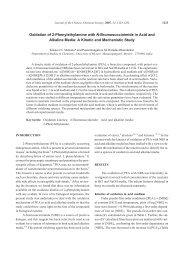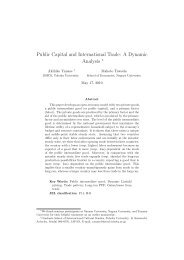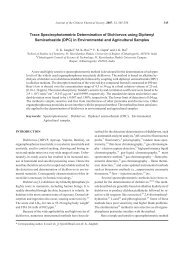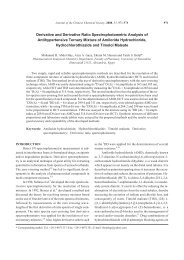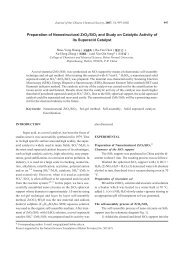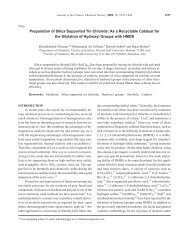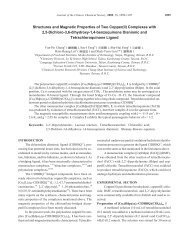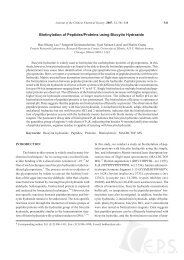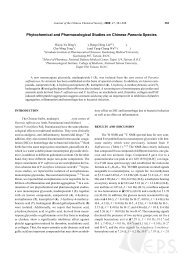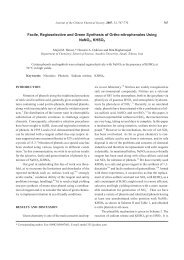Photoinduced Aromatization of Unsymmetrically Substituted 1,4 ...
Photoinduced Aromatization of Unsymmetrically Substituted 1,4 ...
Photoinduced Aromatization of Unsymmetrically Substituted 1,4 ...
Create successful ePaper yourself
Turn your PDF publications into a flip-book with our unique Google optimized e-Paper software.
132 J. Chin. Chem. Soc., Vol. 54, No. 1, 2007 Memarian et al.<br />
argon atmosphere.<br />
RESULTS AND DISCUSSION<br />
Irradiation (280 nm) <strong>of</strong> 15.10 -3 M solution <strong>of</strong> each<br />
<strong>of</strong> 1a-1l in chlor<strong>of</strong>orm by bubbling oxygen or argon through<br />
the solution was followed by thin layer chromatography<br />
(TLC) until the total disappearance <strong>of</strong> 1a-1l. The results are<br />
summarized in Table 1.<br />
Since the aim <strong>of</strong> this study was (i). the investigation<br />
<strong>of</strong> photochemical behavior <strong>of</strong> these compounds, dependent<br />
on the type and nature <strong>of</strong> 4-substituent and (ii). to elucidate<br />
the effect <strong>of</strong> oxygen atmosphere on the rate <strong>of</strong> reactions, we<br />
have carried out simultaneously the photoreactions under<br />
both oxygen and argon atmospheres. Because <strong>of</strong> the similarity<br />
<strong>of</strong> the products obtained on irradiation under both atmospheres,<br />
the products obtained under an argon atmosphere<br />
have not been isolated, except for 1e, and the times<br />
<strong>of</strong> total oxidation are determined by TLC monitoring. For<br />
this purpose, we have taken the same volumes with equal<br />
concentration <strong>of</strong> each <strong>of</strong> the compounds in two different<br />
test tubes and irradiated them simultaneously and continuously<br />
by purging with a stream <strong>of</strong> either oxygen or argon<br />
until total disappearance <strong>of</strong> 1,4-dihydropyridines is observed<br />
by following the reaction by TLC.<br />
The observed fast reaction under oxygen atmosphere<br />
is an indication <strong>of</strong> the involvement <strong>of</strong> the excited singlet<br />
state <strong>of</strong> 1b, 1e, 1i, 1j, 1k and 1l in the reaction, since the excited<br />
singlet state could not be quenched by triplet oxygen.<br />
In the cases <strong>of</strong> 1a, 1c, 1d, 1f, 1g and 1h the excited triplet<br />
state should be involved in the reaction, since a faster pho-<br />
Scheme I<br />
Table 1. Irradiation <strong>of</strong> dihydropyridines 1a-1l under O2 and Ar<br />
O2 Ar<br />
Product (%) I<br />
Time (h) II<br />
Product (%) III<br />
Time (h) II<br />
1a 3a (60) 0.66 3a 0.33<br />
1b 3b (71) 5.5 3b 36<br />
1c 3c (72) 9 3c 3.75<br />
1d 3d (40) 6 3d 5.5<br />
1e 2 (20)<br />
3e (50)<br />
9 2 (18)<br />
3e (49)<br />
22<br />
1f 3f (84) 12.5 3f 8<br />
1g 3g (73) 5.5 3g 3<br />
1h 3h (67) 6 3h 4<br />
1i 3i (65) 7.5 3i 8.5<br />
1j 3j (80) 6 3j 15<br />
1k 2 (63) 1.5 2 5<br />
1l 2 (74) 2.25 2 5<br />
I II<br />
Isolated yield. Irradiation times refer to disappearance <strong>of</strong> the<br />
starting material. III The products have not been isolated except<br />
for 1e and identified only by TLC.<br />
to-oxidation has been observed by bubbling argon through<br />
the solution under irradiation.<br />
We have also investigated the effect <strong>of</strong> the nature <strong>of</strong><br />
solvent on the rate <strong>of</strong> reaction. Whereas irradiation <strong>of</strong> only<br />
compound 1a in ethanol solution after 15 minutes led to the<br />
formation <strong>of</strong> compound 3a in 70% yield, other compounds<br />
were obtained unchanged even after 5-13 hours <strong>of</strong> irradiation<br />
in the same solvent. Therefore, we found that chlor<strong>of</strong>orm<br />
is a suitable solvent for our reaction. Owing to the formation<br />
<strong>of</strong> dichloromethane during the reaction, which has<br />
been proved by GC-analysis <strong>of</strong> the reaction mixture and by<br />
testing for acidity <strong>of</strong> the solution after irradiation (due to<br />
formation <strong>of</strong> HCl), we will propose an electron transfer



